Geography Playlist
19 chapters • 0 completed
The Universe and the Earth
18 topics
Atmosphere and its composition
6 topics
Atmospheric Temperature
11 topics
Atmospheric Moisture
9 topics
Air Mass, Fronts & Cyclones
15 topics
Evolution of Earths Crust, Earthquakes and Volcanoes
23 topics
Interior of The Earth
14 topics
Landforms
25 topics
Geomorphic Processes
10 topics
Movement of Ocean Water
16 topics
Oceans and its Properties
12 topics
Climate of a Region
14 topics
Indian Geography - introduction, Geology
5 topics
Physiography of India
27 topics
Indian Climate
20 topics
Indian Drainage
32 topics
Soil and Natural Vegetation
13 topics
Mineral and Energy Resources, Industries in India
28 topics
Indian Agriculture
22 topics
Chapter 3: Atmospheric Temperature
Chapter TestAtmospheric Temperature – Processes of Heating and Cooling
The Earth's atmosphere gets heated and cooled by four main processes – Radiation, Conduction, Convection, and Advection. These processes regulate temperature distribution, weather phenomena, and energy balance of the planet.
The Earth's atmosphere gets heated and cooled by four main processes – Radiation, Conduction, Convection, and Advection. These processes regulate temperature distribution, weather phenomena, and energy balance of the planet.
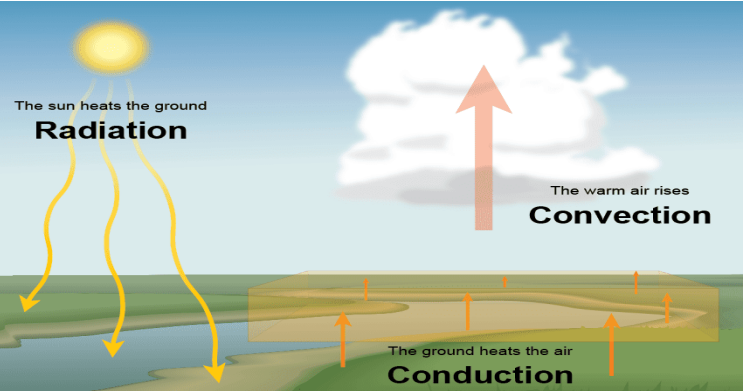
Processes of Heating and Cooling of Atmosphere
| Process | Medium Required | Direction | Rate of Transfer | Example |
|---|---|---|---|---|
| Radiation | No medium | Any (wave propagation) | Fast | Solar radiation reaching Earth |
| Conduction | Yes (solids) | Direct contact | Slow | Surface heating adjacent air |
| Convection | Yes (fluids) | Vertical | Slow–moderate | Warm air rising, clouds forming |
| Advection | Yes (fluids) | Horizontal | Slow–moderate | Winds transferring heat across regions |
Mains Key Points
Prelims Strategy Tips
Insolation
Insolation is the solar energy received by the Earth. Although the Sun emits enormous energy, only a tiny fraction reaches the Earth due to its small size and great distance. Insolation varies with latitude, season, cloud cover, and topography.
Insolation is the solar energy received by the Earth. Although the Sun emits enormous energy, only a tiny fraction reaches the Earth due to its small size and great distance. Insolation varies with latitude, season, cloud cover, and topography.
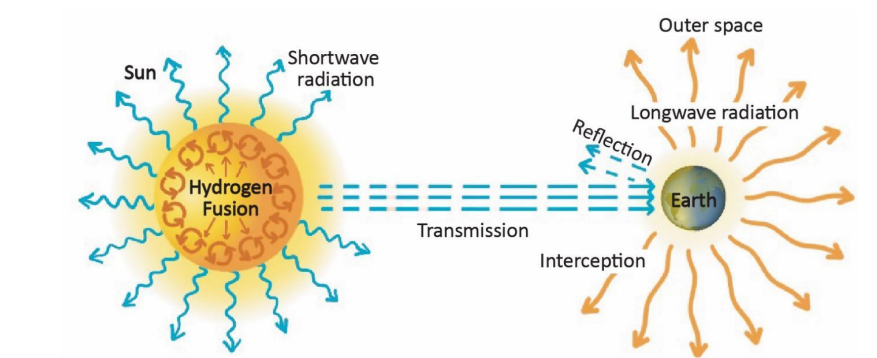
Factors Affecting Insolation
| Factor | Effect on Insolation | Example |
|---|---|---|
| Angle of Incidence | Direct rays = more; oblique rays = less | Equator vs Poles |
| Duration of Day | Longer day = more insolation | Summer vs Winter |
| Atmospheric Transparency | Clouds, dust reduce insolation; clear sky increases | Monsoon vs Desert sky |
| Topography | Slope orientation & altitude affect insolation | South-facing slopes warmer in NH |
Mains Key Points
Prelims Strategy Tips
Heat Budget of the Earth
The heat budget is the balance between incoming solar radiation (insolation) and outgoing terrestrial radiation. Of the total incoming 100 units of solar radiation, about 35% is reflected (Earth’s albedo), 14% absorbed by atmosphere, and 51% absorbed by Earth’s surface. This absorbed energy is eventually reradiated back into space, maintaining the Earth’s energy balance.
The heat budget is the balance between incoming solar radiation (insolation) and outgoing terrestrial radiation. Of the total incoming 100 units of solar radiation, about 35% is reflected (Earth’s albedo), 14% absorbed by atmosphere, and 51% absorbed by Earth’s surface. This absorbed energy is eventually reradiated back into space, maintaining the Earth’s energy balance.
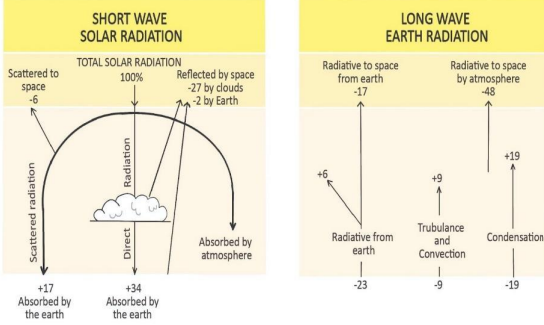
Heat Budget Distribution
| Process | Units |
|---|---|
| Reflected by clouds | 27 |
| Reflected by atmosphere | 6 |
| Reflected by Earth surface (ice/land) | 2 |
| Absorbed by atmosphere | 14 |
| Absorbed by Earth’s surface | 51 |
| Re-radiated by Earth directly | 17 |
| Transferred to atmosphere | 34 |
| Re-radiated by atmosphere | 48 |
Mains Key Points
Prelims Strategy Tips
Latitudinal Heat Balance
Latitudinal Heat Balance refers to the redistribution of solar energy from surplus zones (tropics) to deficit zones (polar regions). It prevents extreme overheating at the equator and freezing at the poles, ensuring global climate stability.
Latitudinal Heat Balance refers to the redistribution of solar energy from surplus zones (tropics) to deficit zones (polar regions). It prevents extreme overheating at the equator and freezing at the poles, ensuring global climate stability.
Latitudinal Heat Balance: Surplus vs Deficit
| Zone | Energy Condition | Impact |
|---|---|---|
| Tropics (40°N – 40°S) | Surplus energy (high insolation) | Drives circulation to poles |
| Mid-Latitudes | Transitional zone | Storm tracks, mixing of warm & cold air |
| Poles | Deficit (low insolation) | Cold climate, energy gained from tropics |
Mains Key Points
Prelims Strategy Tips
Temperature
Temperature is the measure of the intensity of heat in a substance or region. While heat is energy, temperature reflects its effect. Atmospheric temperature distribution is controlled by latitude, altitude, land-water contrast, ocean currents, winds, and local geographical features.
Temperature is the measure of the intensity of heat in a substance or region. While heat is energy, temperature reflects its effect. Atmospheric temperature distribution is controlled by latitude, altitude, land-water contrast, ocean currents, winds, and local geographical features.
Major Factors Influencing Temperature
| Factor | Effect | Example |
|---|---|---|
| Latitude | High at equator, low at poles | Equator vs Polar regions |
| Altitude | Decreases with height | Quito vs Guayaquil |
| Land-Water Contrast | Land heats faster, water slower | Mumbai vs Nagpur |
| Ocean Currents | Warm ↑, Cold ↓ temperature | Gulf Stream, Labrador |
| Air Mass | Warm ↑, Cold ↓ temperature | Cold waves in N. India |
| Local Winds | Sudden ↑ or ↓ | Sirocco, Mistral, Chinook |
| Slope & Aspect | Sunny slope warmer | South vs North slope of Alps |
| Surface Nature | Albedo effect | Deserts hottest, Snowfields coolest |
Mains Key Points
Prelims Strategy Tips
Horizontal Distribution of Temperature
Horizontal distribution of temperature is studied through isotherms, lines connecting equal temperatures. Isotherms generally follow latitudes, but deviate due to land-sea contrast, ocean currents, altitude, and winds. The deviations are more prominent in the Northern Hemisphere (large landmass) than in the Southern Hemisphere (dominated by oceans).
Horizontal distribution of temperature is studied through isotherms, lines connecting equal temperatures. Isotherms generally follow latitudes, but deviate due to land-sea contrast, ocean currents, altitude, and winds. The deviations are more prominent in the Northern Hemisphere (large landmass) than in the Southern Hemisphere (dominated by oceans).
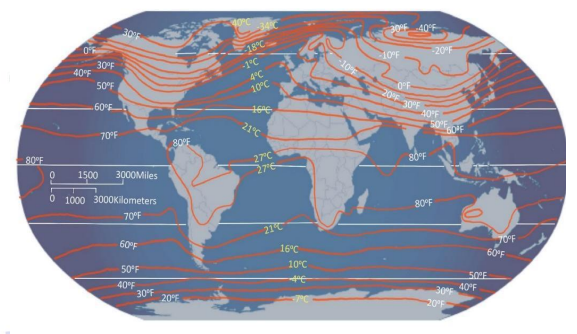
Isotherm Patterns in January and July
| Hemisphere | January Behavior | July Behavior |
|---|---|---|
| Northern Hemisphere | Isotherms bend southward over continents, northward over oceans. | Isotherms bend northward over land, southward over oceans. |
| Southern Hemisphere | Isotherms nearly parallel to latitude (ocean dominance). | Isotherms shift equatorward (winter), deviations smaller. |
Mains Key Points
Prelims Strategy Tips
Isotherm Behavior in July & Temperature Variations
In July, isotherms are mostly parallel to latitudes, with extreme temperature variations between continental interiors (like NE Eurasia) and equatorial oceans. Concepts like thermal anomaly, temperature range, and diurnal variation explain local and global differences in heat distribution.
In July, isotherms are mostly parallel to latitudes, with extreme temperature variations between continental interiors (like NE Eurasia) and equatorial oceans. Concepts like thermal anomaly, temperature range, and diurnal variation explain local and global differences in heat distribution.
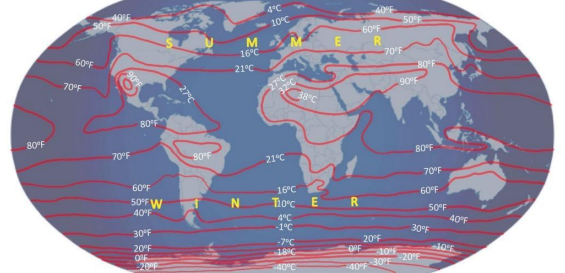
Temperature Ranges and Examples
| Type | Definition | Example |
|---|---|---|
| Temperature Anomaly | Difference from mean of latitude | Western Europe warmer than same latitudes in Canada |
| Diurnal Range | Max–Min temperature in a day | Sahara Desert (high), Amazon Basin (low) |
| Annual Range | Difference between hottest & coldest months | Siberia (high), Equatorial Africa (low) |
Mains Key Points
Prelims Strategy Tips
Temperature Inversion
Temperature inversion occurs when normal lapse rate reverses and air near the surface becomes colder than the air above. This creates a stable atmosphere that traps pollutants and moisture, leading to smog, fog, frost, and aviation hazards.
Temperature inversion occurs when normal lapse rate reverses and air near the surface becomes colder than the air above. This creates a stable atmosphere that traps pollutants and moisture, leading to smog, fog, frost, and aviation hazards.
Types of Temperature Inversion
| Type | Characteristics | Example |
|---|---|---|
| Radiation | Ground cools faster at night, cold air trapped | Kashmir, Colorado |
| Advection | Warm air flows over cold ocean currents | California coast |
| Subsidence | High pressure, sinking air warms aloft | Sahara Desert |
| Valley | Cold dense air accumulates in valleys | Kathmandu, Swiss Alps |
| Frontal | Warm air overrides dense cold air | Cyclonic fronts |
Mains Key Points
Prelims Strategy Tips
Significance of Temperature Inversion
Temperature inversion influences weather, climate, agriculture, and human activities. While it stabilizes the atmosphere, it also traps pollutants, reduces rainfall, and creates fog, affecting health, transport, and environment.
Temperature inversion influences weather, climate, agriculture, and human activities. While it stabilizes the atmosphere, it also traps pollutants, reduces rainfall, and creates fog, affecting health, transport, and environment.
Mains Key Points
Prelims Strategy Tips
Temperature Zones of the Earth
Earth is divided into three major temperature zones based on latitude – Torrid (Tropical), Temperate, and Frigid. These zones differ in sunlight received, climatic features, vegetation, and human activities.
Earth is divided into three major temperature zones based on latitude – Torrid (Tropical), Temperate, and Frigid. These zones differ in sunlight received, climatic features, vegetation, and human activities.
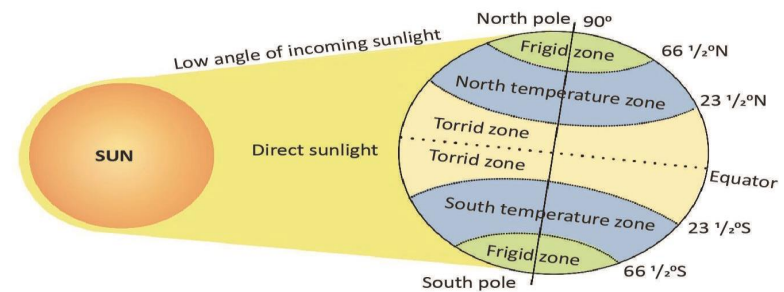
Earth’s Temperature Zones
| Zone | Extent | Climatic Features | Vegetation | Human Activities |
|---|---|---|---|---|
| Torrid (Tropical) | 23.5°N–23.5°S | High temperatures, direct sunrays, deserts & monsoons | Rainforests, monsoon forests, savanna, desert vegetation | Rice, sugarcane, coffee farming; dense population |
| Temperate | 23.5°–66.5° N & S | Moderate temperature, seasonal variation | Deciduous forests, conifers, Mediterranean shrubs | Wheat, maize, grapes, olives; industrialized regions |
| Frigid (Polar) | 66.5°–90° N & S | Freezing, long polar night/day, very low precipitation | Tundra – mosses, lichens, dwarf shrubs | Sparse population; reindeer herding, oil, fishing |
Mains Key Points
Prelims Strategy Tips
Rossby Waves
Rossby waves are large-scale atmospheric undulations in mid-latitudes, associated with the polar-front jet stream. They balance heat between equator and poles, influence cyclonic activity, jet stream patterns, and extreme weather events.
Rossby waves are large-scale atmospheric undulations in mid-latitudes, associated with the polar-front jet stream. They balance heat between equator and poles, influence cyclonic activity, jet stream patterns, and extreme weather events.
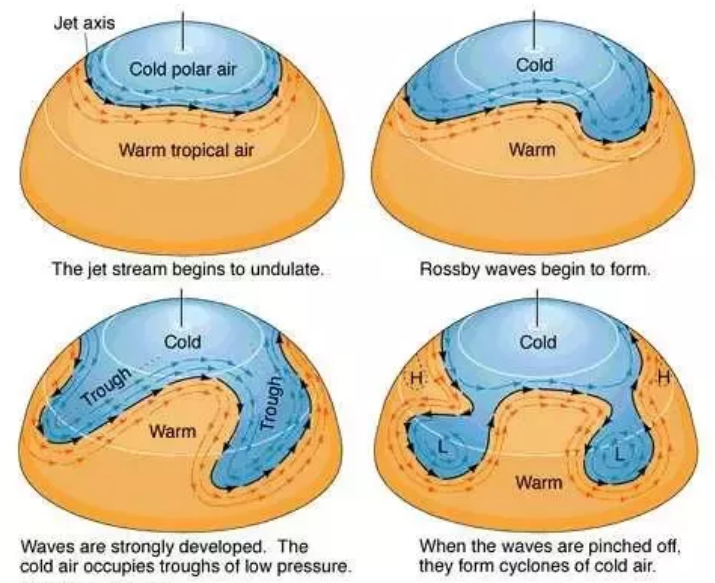
Rossby Waves – Key Features
| Aspect | Details |
|---|---|
| Scale | Planetary (thousands of km) |
| Cause | Coriolis effect + temperature gradient |
| Location | Mid-latitudes, Ferrel cell, Jet stream |
| Motion | Westward relative to airflow |
| Effect | Ridges & troughs, control storm tracks |
Mains Key Points
Prelims Strategy Tips
Chapter Complete!
Ready to move to the next chapter?
